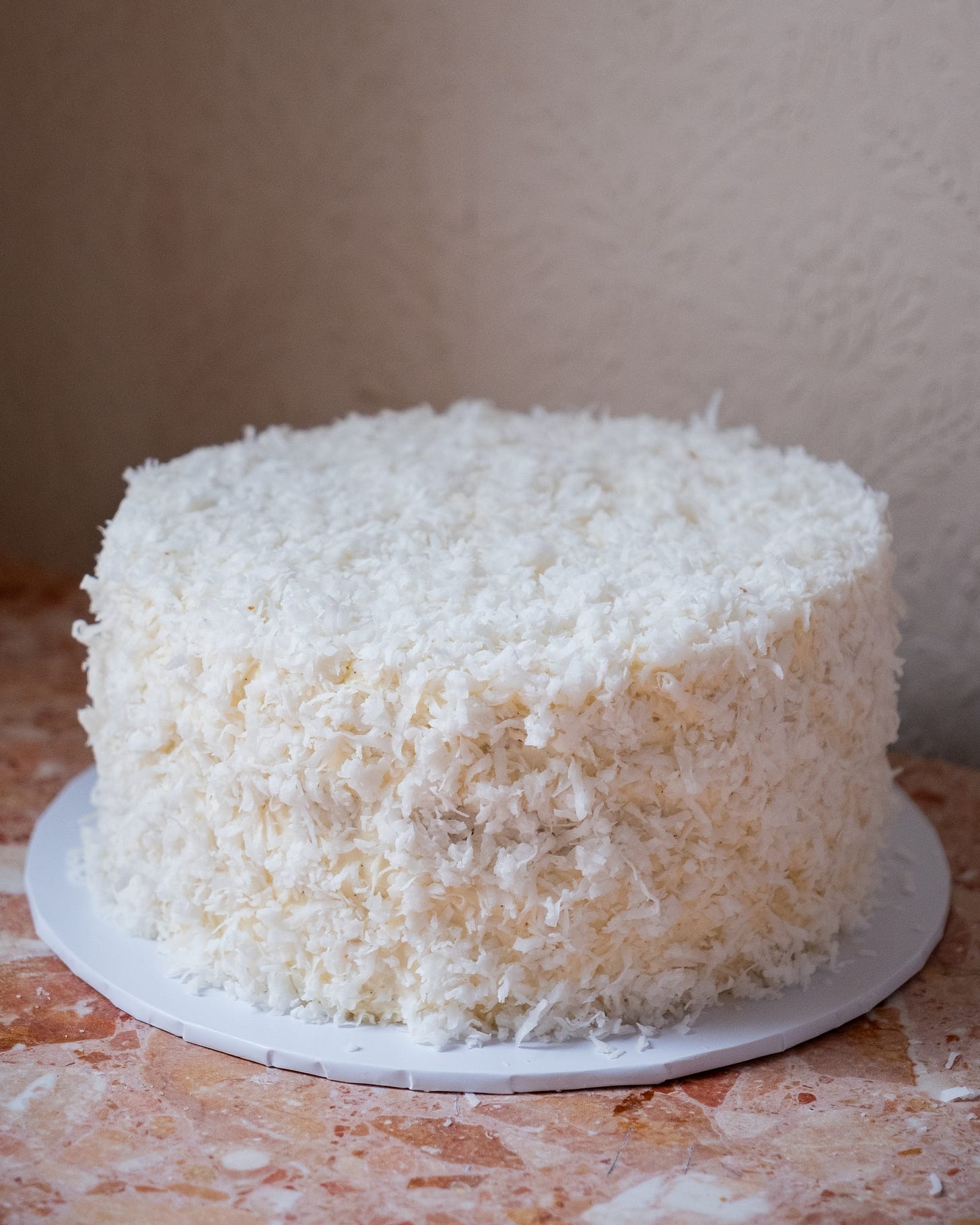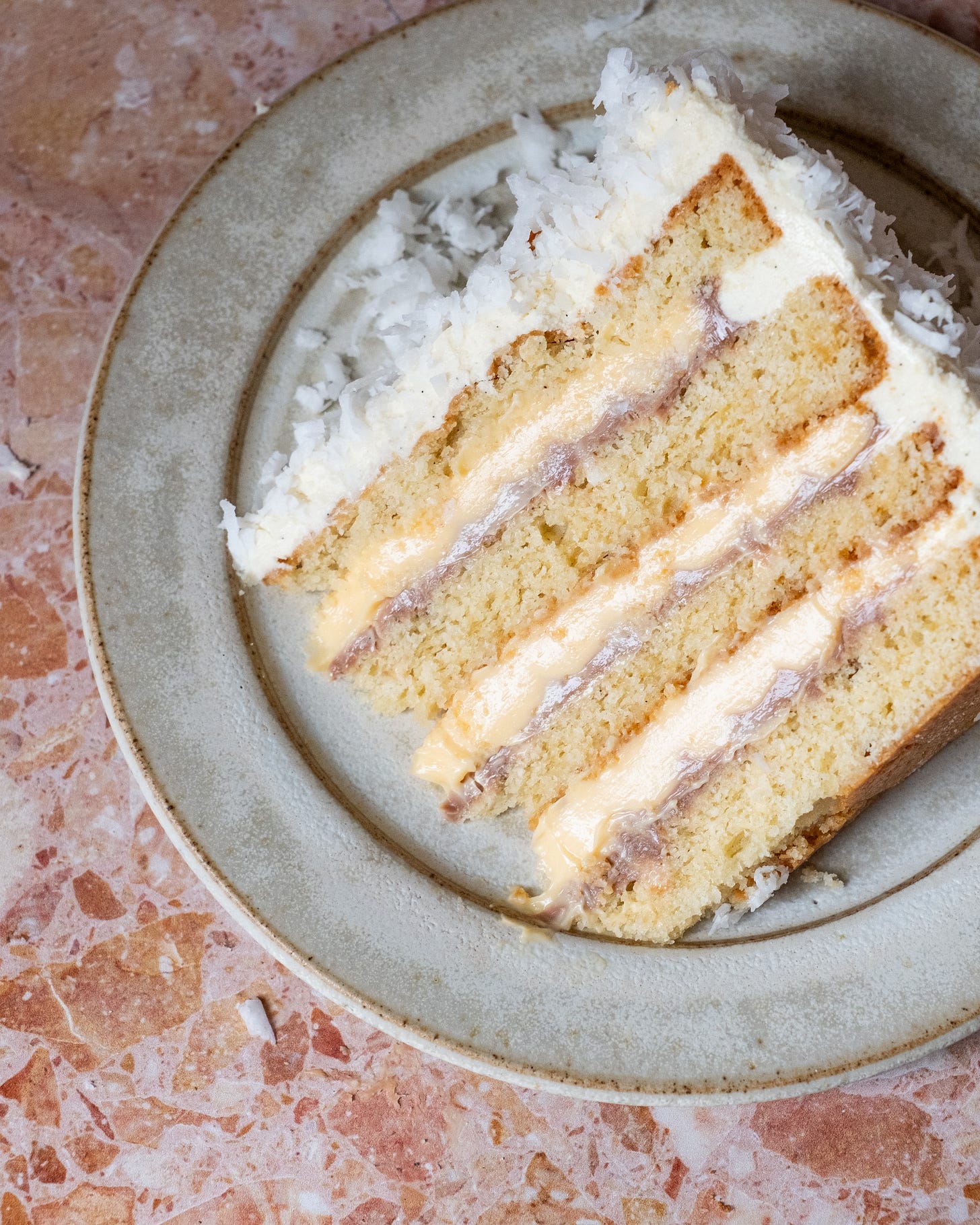🎉 Welcome to my newsletter, The Boy Who Bakes, a subscriber-supported newsletter, dedicated to all things baked. For more bonus posts, filled with exclusive recipes, you can become a paid subscriber for the weekly newsletter, Second Helpings. It costs just £5 a month and, as well as the weekly recipes, also unlocks access to the full archive of past recipes. To subscribe, to either the paid or free newsletter, click the link below.🎉
Hello, Happy Friday!
As I mentioned a couple of weeks ago, I decided that turning 40 required an appropriate amount of cake, and one just didn’t seem enough. For cake number two, the big boy birthday cake, I went a little over the top. This is a cake you make to treat yourself when you want to spend a weekend baking. It’s a lot – this is far from a quickly whipped-up affair; this is a serious cake.
For the flavour, my starting point was a yuzu cream. In Copenhagen, a few weeks back, we had a delicious yuzu pastry from Hart Bageri, and it really reminded me how much I love this citrus and how rarely I actually use it. Working outwards, I knew that the yuzu would pair nicely with coconut, and then, because it is my personal belief that a birthday needs to involve chocolate, I decided to add a little milk chocolate ganache. The finished cake ended up as quite the mouthful. Four thin vanilla cake layers, layered with a milk chocolate ganache and a generous layer of yuzu cream, which is then all coated in a coconut ermine buttercream and a blanket of coconut.
Yuzu Cream
For the yuzu cream I used a version of my lemon cream recipe, which I have been using for years. It is a modified lemon curd where a larger proportion of butter is used but also added once the curd has been cooked and cooled slightly, emulsifying in the butter to give a thick and creamy finish. As I can never stop playing around with my food, I’ve tweaked it a little. Normally I make the cream with a mixture of yolks and whole eggs, which gives a rich and incredibly creamy texture, but for this version, I switched to only whole eggs, the extra white helping to make a slightly firmer cream which works perfectly for a cake filling. The other change I made is the cooking method. This sort of cream is normally made using a bain-marie. If you’ve made this sort of cream before, you’ll know this method can be a bit of a pain. A bain-marie is a form of indirect heat, and getting the mixture to reach the magic 82ºC can be a slow, if not impossible, task. If you do use this method, one thing which really helps is a metal bowl – the bowl will transfer heat to the curd mixture more efficiently and help you reach that magic temperature. To overcome this issue, I, however, prefer to use a slightly modified approach; I now make it like a crème anglaise. Cooking it like this makes for a cream that cooks with efficiency – you just need to stir constantly and keep the heat very low to prevent overcooking. For the actual yuzu, it's not exactly an ingredient you’ll find in Sainsbury's or Tesco. Whilst it can be found in some Asian grocers or from speciality suppliers online, the easiest form to use is bottled yuzu juice, especially as the season is relatively short. Whilst some yuzu juice is available in supermarkets, it tends to be diluted and low quality, so I prefer to buy something online. This cake was a treat for my birthday, so I was happy to splash out a little, but I should warn you, good yuzu juice is quite expensive. If I was making it for a slightly less special occasion, I would probably make this more pocket-friendly and switch out the yuzu for lime juice. The cost would be significantly lower, and the lime cream would also work incredibly well with everything else going on in this recipe. But this time, I treated myself to some yuzu, you only turn 40 once.
Coconut Buttercream
When it comes to the buttercream, I felt I had two choices: a German buttercream made with a custard base or ermine buttercream made with a cooked flour base. Both of these buttercreams are made with a substantial amount of liquid, normally milk, so they would be ideal candidates for making a coconut buttercream – subbing in coconut milk for the regular dairy. I settled on ermine buttercream because it is made without egg and would leave the coconut flavouring nice and clean.
If you’ve never made ermine frosting before, let me be the one to introduce you to this old-fashioned marvel. With many buttercreams you have a base that butter is added to, be that custard in German, condensed milk in Russian, or meringue in Swiss or Italian. Ermine frosting is a little different as it uses a type of roux. Flour, sugar and milk are cooked together to make a thick paste and then allowed to cool. You then beat your butter until soft and pale, then slowly add in the paste and watch as the mixture transforms into a delicious buttercream. The pros of this buttercream are its low level of sweetness, clarity of flavour and fluffy texture. The cons are the potential floury taste, moussey texture and also its low level of sweetness. The frosting is one of the least sweet you can make, and this can be both a pro and a con depending on the intended use and your own personal taste. Because it is made with a large amount of liquid, it is great for infusing flavours in the buttercream – plus there is no egg or anything else to dull or dilute the flavour. But, because the base is cooked flour, there is a risk the finished buttercream will taste floury. To prevent this from happening, it is key to cook the roux base fully to ensure the flour is fully cooked out, much in the same way you cook out a pastry cream. The texture also isn’t quite as silky as a Swiss or Italian meringue-based buttercream; whilst very smooth and light, it has a slightly more moussey texture, and it doesn’t spread quite as easily as meringue-based buttercreams.
Coconut
Before we get to the recipe, a quick word on coconut. The eagle-eyed amongst you might have noticed this isn’t made with desiccated or flaked coconut, what you’d expect me to use in the UK. Whilst I love desiccated coconut, I happened to have a bag of American ‘angel flake coconut’ and opted to use this instead. For my fellow Brits who’ve never heard of this type of coconut before – let me explain. Angel flake coconut is long, thin strands of coconut, much bigger than desiccated but not wide and flat like coconut flakes. The coconut is sweetened, but it is also moist, a textural difference that is particularly welcome if you find desiccated coconut far too dry and chewy. I wanted to point this out simply because you can use whichever form of coconut you prefer. If you do want to try the angel flake coconut, it is easily available on Amazon UK (if a tad expensive), it also very easy to find from American ingredient stores.
Keep reading with a 7-day free trial
Subscribe to The Boy Who Bakes to keep reading this post and get 7 days of free access to the full post archives.







